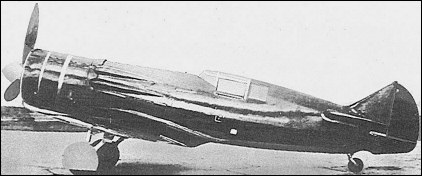|
| Establishing an OKB (Experimental Construction Bureau) in the autumn of 1938, Vladimir P Yatsenko was ordered to build two prototypes of a single-seat fighter which he had designed while supervising production of the Kocherigin DI-6. Assigned the designation I-28 by the NKAP (State Commissariat for Aviation Industry), the fighter was a low-wing cantilever monoplane of mixed construction, with a two-spar wooden wing, a steel-tube forward fuselage and a wooden semi-monocoque aft fuselage, the whole being covered by birch shpon - impregnated birch strips glued across the grain. The wing was of shallow inverted-gull form and armament consisted of two 20mm ShVAK cannon and two 7.62mm ShKAS machine guns, all synchronised and firing through the engine cowling lip. The I-28 was to have been powered by a 1,500hp Shvetsov M-9018-cylinder radial engine, but the non-availability of this power plant led to adoption of the 14-cylinder Tumansky M-87 affording only 930hp. Completed on 30 April 1939, and flown shortly afterwards, the first prototype was submitted to the NIl V-VS for State Acceptance testing in June, but broke up in a terminal velocity dive. The second prototype, completed in August 1939, differed in having a marginally more powerful M-87B engine and an armament of one ShVAK cannon and two 12.7mm UBS machine guns. This prototype lacked the aft-sliding cockpit canopy of the first aircraft. Production of a pre-series of I-28 fighters powered by the 1,100hp Tumansky M-88B engine had meanwhile commenced, but only five had been completed by February 1940, when the programme was terminated and Yatsenko's GAZ transferred to the Yakovlev OKB, the I-28 designation being re-used by the NKAP for a Yakovlev fighter.
 | A three-view drawing (1610 x 1190) |
| MODEL | I-28 (2nd prototype) |
| WEIGHTS |
| Take-off weight | 2720 kg | 5997 lb |
| Empty weight | 2257 kg | 4976 lb |
| DIMENSIONS |
| Wingspan | 10.40 m | 34 ft 1 in |
| Length | 8.54 m | 28 ft 0 in |
| Wing area | 16.50 m2 | 177.60 sq ft |
| PERFORMANCE |
| Max. speed | 576 km/h | 358 mph |
| Range | 800 km | 497 miles |
| bombardier, e-mail, 13.12.2011 21:14 The plane had similar performance to the Yak-1,MiG-1 and LaGG-1 that were produced instead of it but without the vulnerable water-cooled engines that these aircraft used.In addition to a good fighter the I-28 would have been a very good attack aircraft because it had a sturdy radial engine. reply | | Sturm, 31.05.2010 03:48 Looks like the love-child of a D.520 and an IAR 80 reply | | caldrail, e-mail, 11.05.2010 12:14 As far as I'm aware, this aircraft failed to make an impression, not least because it proved structurally weak in acceptance trials, and by the time another version was ready, other designs had become more attractive to the Russian Air Force. Aircraft production in world war two was all about priorities and sales competition. There simply wasn't a good case to put this aeroplane into service. Nothing to do with Stalin whatsoever. reply | | Treetop64, 24.12.2009 05:59 This might have been a promising aircraft once the airframe matured and the Shvetsov was made available. It's not like the S.U. didn't have the resources at the time to support further development of this machine, even though the LaGG-3, MiG-3, and Yak-1 were all going into production. Anything would have been better than persisting with the old Polikarpovs. reply | |
| | dr nick stage--PHD, e-mail, 09.11.2007 19:52 Like so many promising pre-World War Two Soviet
Air Force planes, Stalin's constant interference made
the I-28 aircraft a "lemon", not the aircraft design
bureaus.
No wonder Stalin almost lost the war on the "Russian front". Yatsenko's plane deserved another chance, that
Stalin sabotaged out of Stalin's paranoia with far-sighted
aircraft designers and after the Second world war, Russia's early
lead in rockets. reply |
|
Do you have any comments?
|
| 
All the World's Rotorcraft |






